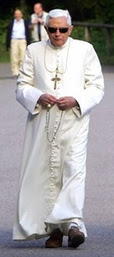A tablet in the forecourt of San Gregorio al Celio records the following saints and worthies who came from this place in the days of its first flowering, after St Gregory turned his family home into a monastery (originally dedicated to St Andrew, to whom St Gregory had a great devotion - hence the naming of St Andrew in the Embolism at Mass):
- St Gregory himself, founder and father of the monastery;
- St Eleutherius, abbot;
- Hilarion, abbot;
- St Augustine, Apostle of the English;
- St Lawrence, Archbishop of Canterbury;
- St Mellitus, Bishop of London and soon afterward Archbishop of Canterbury;
- St Justus, Bishop of Rochester (Roffensis);
- St Paulinus, Archbishop of York;
- St Maximianus, Bishop of Syracuse;
- SS Antonius, Merulus and John, monks;
- St Peter, Abbot of Canterbury;
- Honorius, Archbishop of Canterbury;
- Merinianus, Archbishop of Ravenna;
- Probus, custodian of the house of pilgrims (curator xenodochii) at Jerusalem, chosen by St Gregory;
- Sabinus, Bishop of Callipolis;
- Felix, Bishop of Messina;
- Gregory, Cardinal Deacon of St Eustachius.
- Here also lived for a long time the mother of St Gregory, St Silvia.
Most of these men were sent on the English Mission - or should we call it, as the Anglicans mocked at English Catholics in recent centuries, the Italian Mission?
St Augustine of Canterbury and his monks preach the Gospel to King Ethelbert of Kent.
So the Church in England, which converted the pagan Angles, Jutes and Saxons, was Roman as Rome itself... none of these men forswore the Faith, broke with the Pope, reviled the Roman Mass, rejected the Saints, married against the canons of the Western Church, nor chose Caesar over God. Let Anglicans attend to this lesson: the witness of the first millennium of Christianity in England is against them.








No comments:
Post a Comment